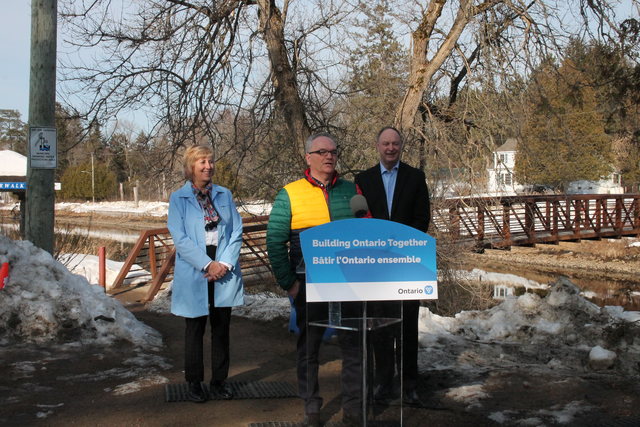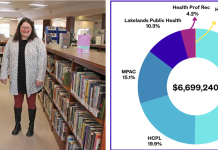By Lisa Gervais
With a low Gull River in the background, Ontario unveiled its flooding strategy in Minden March 9.
Minister of Natural Resources and Forestry John Yakabuski was joined by Infrastructure Minister and MPP Laurie Scott and Minden Mayor Brent Devolin at a podium set up at the entrance to the town’s Riverwalk.
Federal MP Jamie Schmale was in the audience as were councillors and staff of Minden Hills council.
Yakabuski said Ontario’s Flooding Strategy was developed after extensive public consultation and the advice of Doug McNeil, the province’s special advisor on flooding.
“We know that we can’t prevent flooding in Ontario – we can only reduce the impacts when it happens,” Yakabuski said. “This strategy is designed to help us to do just that, by introducing a series of new and enhanced actions that will reduce flood risks and make our province better prepared for flooding events, better equipped to respond to them and more capable of recovery from them quickly.”
He emphasized it had to be a multi-jurisdictional approach, working with the federal and municipal governments, homeowners, conservation authorities, industry and Indigenous communities.
He unveiled five strategies.
The first is understanding flood risks through updated floodplain mapping and increasing access to flood-related information.
The second is strengthening governance of flood risks through provincial policy to ensure local development is directed away from areas where flooding and erosion present unacceptable risks.
The third is enhancing flood preparedness through the use of state-of-the-art science and technology.
The fourth is enhancing flood response and recovery by improving how the province and its partners receive and respond to municipal requests for assistance.
The fifth is investing in flood risk reduction by working with the federal government to increase investment in critical areas such as mapping and infrastructure.
Devolin said, while “the backdrop may be a bit surprising with low water levels,” water issues are a big deal on the Trent Severn Waterway in the County of Haliburton. “Dealing with them, and the changing environment that we have, requires partnerships.” He said they’d seen an evolution in those partnerships, particularly with the federal government’s multi-million-dollar investment in dam infrastructure across the county.
“I’m hoping that this is the beginning of a new day and a new partnership, with our municipal partners with the MNRF, so that mitigation measures, and with the ever-changing water levels and the environment that we have, that we can protect and look after the interests of all of our taxpayers,” he said.
Yakabuski applauded Minden Hills for completing a drainage study to provide more accurate information on four flood-prone areas as well as installing a jet valve to lessen the likelihood of flooding for approximately 50 homes.
Scott said that while the Gull River was currently low, Minden, other Haliburton County municipalities and those in the North Kawartha’s had “gone through some very rough flooding times in the past. We recognized that we needed to look at new approaches to flooding. We’re here today because we have shown a wonderful community collaborative approach with all agencies, and of course, the immense strength of people not only in Minden but the County of Haliburton when flooding times happen.”
Yakabuski highlighted one feature, an updated Ontario website to better communicate with homeowners to help them be better prepared, and know who to contact during and after a flood. It is ontario.ca/floods





